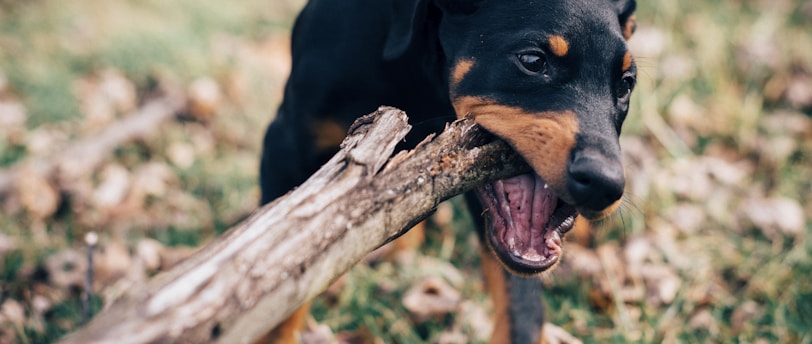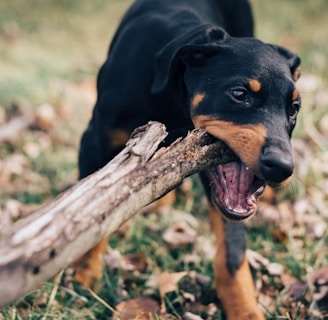The Comprehensive Guide to Puppy-Proofing Your Home for Your Doberman
11/2/20233 min read


The Comprehensive Guide to Puppy-Proofing Your Home for Your Doberman
Welcome to our comprehensive guide on creating a safe and secure environment for your Doberman puppy. Bringing a new furry friend into your home is an exciting time, but it also comes with responsibilities. One of the most important tasks is puppy-proofing your home to prevent accidents and protect your Doberman. Whether you're a first-time Doberman owner or need a refresher on puppy-proofing, this article provides valuable insights and practical advice to maintain a safe and happy living space for both you and your puppy.
Step 1: Assessing Potential Hazards
Before you begin puppy-proofing, it's crucial to assess your home for potential hazards. Dobermans are curious and energetic, so it's important to identify and eliminate any dangers that could harm your puppy. Here are some areas to consider:
Electrical Outlets: Cover all electrical outlets with outlet covers to prevent your puppy from sticking their nose or paws in them.
Cords and Wires: Secure cords and wires out of your puppy's reach or use cord protectors to prevent chewing.
Chemicals and Cleaning Products: Store all chemicals and cleaning products in locked cabinets or high shelves to prevent accidental ingestion.
Plants: Some plants can be toxic to dogs. Research and remove any plants that may be harmful if ingested.
Trash Cans: Invest in a dog-proof trash can or keep your trash can in a secure location to prevent your puppy from rummaging through it.
Step 2: Securing Hazardous Items
Once you've identified potential hazards, it's time to secure them to ensure your puppy's safety. Here are some tips:
Doors and Cabinets: Install baby gates or use door handle covers to restrict access to rooms or areas with hazardous items.
Trash Cans: Use a dog-proof trash can with a secure lid or keep your trash can in a cabinet or closet.
Medications: Keep all medications out of reach in a locked cabinet or high shelf.
Household Chemicals: Store household chemicals in a locked cabinet or high shelf.
Small Objects: Pick up small objects such as coins, buttons, or jewelry that could pose a choking hazard.
Step 3: Creating a Safe Living Space
Now that you've secured potential hazards, it's time to create a safe living space for your Doberman puppy. Here are some additional tips:
Provide a Safe Zone: Set up a designated area for your puppy with a comfortable bed, toys, and water bowl.
Use Pet Gates: Install pet gates to restrict access to certain areas of your home.
Remove Toxic Plants: Remove any toxic plants from your home or keep them out of reach.
Secure Furniture: Anchor heavy furniture to the wall to prevent it from tipping over if your puppy tries to climb on it.
Keep Food and Treats Secure: Store food and treats in sealed containers to prevent your puppy from accessing them.
Step 4: Supervision and Training
Puppy-proofing is not a one-time task. It's important to supervise your Doberman puppy and provide ongoing training to reinforce good behavior. Here are some tips:
Supervise Your Puppy: Keep a close eye on your puppy, especially during the early stages of puppy-proofing.
Redirect Undesirable Behavior: If your puppy starts chewing on something they shouldn't, redirect their attention to an appropriate toy or chew.
Provide Mental Stimulation: Use puzzle toys and interactive games to keep your puppy mentally stimulated and prevent destructive behavior.
Enroll in Puppy Training Classes: Consider enrolling your Doberman puppy in obedience classes to learn basic commands and good behavior.
Reward Good Behavior: Use positive reinforcement, such as treats and praise, to reward your puppy for good behavior.
Conclusion
Puppy-proofing your home is an essential step in ensuring the safety and well-being of your Doberman puppy. By assessing potential hazards, securing dangerous items, and creating a safe living space, you can prevent accidents and create a hazard-free environment for your furry friend. Remember to provide ongoing supervision and training to reinforce good behavior. With these steps in place, you can enjoy a safe and happy living space for both you and your Doberman.
Useful links
Our Contacts
Email: info@lancasterdobermann.com
Phone Number: +1 561-376-2923
Our Store Address
1595 Newport Blvd, Costa Mesa, CA
